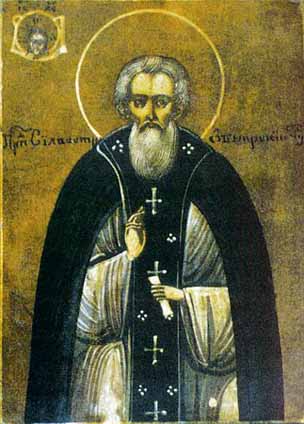
The Monk Sylvester (Syl'vestr) of Obnorsk
Commemorated on April 25
The Monk Sylvester
(Syl'vestr) of Obnorsk was a disciple and novice under the Monk Sergei of
Radonezh (+ 1392, Comm. 25 September and 5 July). After completing obedience at
the Trinity monastery, the Monk Sylvester received blessing for
wilderness-dwelling.
In the deep forest at
the River Obnora, flowing into the River Kostroma, he set up at his chosen spot
a cross and began to asceticise. For a long time no one knew about the holy
hermit. His cell was by chance discovered by a peasant who had lost his way. He
told the distraught hermit, how he had come to this place, over which earlier
he had seen luminous rays, and then pillars of cloud. The monk shed tears of
sorrow, that the place of his solitude had been found out. The pilgrim besought
the saint to tell about himself.

The Monk Sylvester
said, that he was already living here no short while, and that he ate tree bark
and roots. At first he became weak without bread and fell on the ground from
his weakness. But then an Angel appeared to him in the guise of a wondrous man
and touched his hand. From that moment the Monk Sylvester did not experience
any distress. And then the peasant another time, this time deliberately, came
back to the monk and brought him bread and flour for reserve supply.
This one meeting was
sufficient for the exploits of the hermit to become known to many. Soon
peasants began to come to him from the surrounding though not close
settlements. The Monk Sylvester did not refuse them to build cells alongside
him.
When the brethren had
gathered, the monk himself set off to Moscow and petitioned of Sainted Alexei
(1354-1378, Comm. 12 February) blessing for the construction of a temple in
honour of the Resurrection (Voskresenie) of Christ. The sainted-hierarch
entrusted to him an antimins ["antimension" or 'corporal" for
the altar‑table, needful for celebrating of Divine Liturgy], and made him
hegumen of the monastery. With the construction of the church the number of
brethren quickly grew, and the monk frequently withdrew for prayer into the
dense forest. This spot received the name "Commanded-Grove", since
the Monk Sylvester commanded that no trees should be cut there. In the thick of
this grove the monk himself dug out three wells, and a fourth – on the side of
an hill at the River Obnora. When the monk returned from his solitude, there
usually awaited him around the monastery a number of people, and each wanted to
receive his blessing and hear his advice.
When the saint fell
into a fatal illness, the brethren, who were distressed about his going off
into solitude, were even more distressed about the impending end of the saint.
"Grieve not over this, my beloved brethren, – the monk said to them in
solace, – for in everything is the will of God. Keep the commandments of the
Lord and fear not in this life to suffer misfortune, so as to receive reward in
Heaven. If indeed I have boldness before the Lord and my deed be pleasing to Him,
then this holy place will not diminish with my departure. But pray the Lord God
and His All-Pure Mother, that ye be delivered from temptation of evil".
The monk died on 25 April 1479 and was buried towards the right side of the
wooden Resurrection church.
There has been
preserved from the year 1645 a record of miracles of the monk, in which 23
miracles are described. In quite a number the monk healed from demonic‑possession
(12 cases) and delirium, and from eye-afflictions (6 cases). A lesson‑teaching
miracle occurred in 1645. The priestmonk Job of the monastery directed peasants
to cut down the interdicted forest-grove for firewood, and for this he was
struck blind. After four weeks he acknowledged his sin, repented and gave a vow
not to act on his own will, but to do everything on the advice of the brethren.
The priestmonk finished out the molieben in church, after which he was brought
up to the reliquary of the Monk Sylvester, and there he regained his sight.
© 1996-2001 by translator Fr. S. Janos.